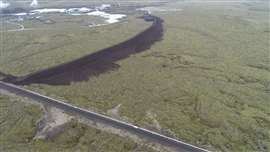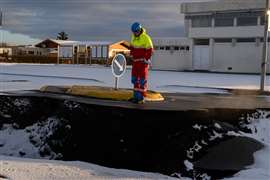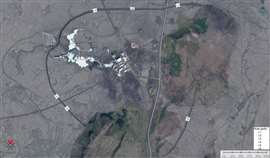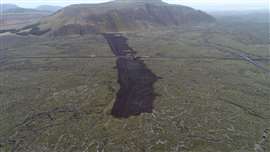Read this article in Français Deutsch Italiano Português Español
The construction teams working to hold back a volcano
06 December 2023
With Iceland shaken by hundreds of earthquakes a day, scientists are warning of an imminent volcanic eruption on the Reykjanes Peninsula. Ari Guđmundsson, division manager at Icelandic engineering company Verkís, tells Lucy Barnard how construction teams in Iceland are working round the clock to protect the country’s main power plant from what could be catastrophic damage.
 The new lava barrier. Photo: Verkís
The new lava barrier. Photo: Verkís
The Grindavíkurvegur Road in Iceland’s Reykjanes Peninsula runs through a dramatic landscape of bare rock and windswept grasses as far as the eye can see.
Ordinarily the road is busy carrying tour busses packed with tourists flocking to see Iceland’s famous Blue Lagoon geothermal spa.
But with the nearby town of Grindavík evacuated after magma induced seismic activity tore vast chasms through the streets of the town, hundreds of earthquakes shaking the area daily, and volcanologists predicting an imminent eruption, these are anything but ordinary times.
Instead, the road lies closed to ordinary traffic while a steady succession of trucks and heavy machinery roar past, loaded with earth and rock mined from the nearby Stapafell mountain, carrying the material to sites where teams of construction workers are busy piling it, and other loose material from the site, into 6-7-meter-high walls stretching into the horizon.
The work is centered around Iceland’s Svartsengi geothermal power station – one of Iceland’s most important pieces of infrastructure which supplies both electricity and district heating to around 30,000 people (Iceland’s total population in 2023 is estimated to be 376,289).
Construction work started on 15 November with a team of around 70 people working around the clock to build the two barriers; one stretching for around 4km around Svartsengi and the Blue Lagoon tourist spot while a second shorter barrier stretches for around 1.5km along the Sundhnúkar crater row.
‘Working day and night’
Ari Guđmundsson, division manager at Icelandic engineering company Verkís, and the man in charge of coordinating the construction works points to a large map of the area.
“We are working both day shifts and night shifts, 22 hours a day to get this done,” he says. “We are using trucks to move the material to this area and then using bulldozers, the largest available in Iceland to pile up the gravel. We are using Caterpillar D11s, some D10s and D9s. We have some heavy Komatsu and Liebherr bulldozers too.”
He says that so far, the works are around 50% complete and he expects them to be finished by 15 December.
Six of Iceland’s biggest contractors are working on the project, some employing sub-contractors as well in what many believe is a race against time to build the barriers before the volcano erupts.
Working under the constant threat of not only a volcanic eruption but also of poisonous gasses escaping from the earth below, everyone with access to the site is equipped with a Tetra trunked radio to remain in constant communication in case an emergency site clearance becomes necessary, and teams are required to carry instruments detecting volcanic gasses.
 A member of the emergency team looks at the open fissure in the ground in the evacuated town of Grindavik, Iceland on 23 November 2023. Photo by Raul Moreno / SOPA Images/ Reuters.
A member of the emergency team looks at the open fissure in the ground in the evacuated town of Grindavik, Iceland on 23 November 2023. Photo by Raul Moreno / SOPA Images/ Reuters.
“The week before there was something showing on the instrument. We cleared the site immediately. It happened very quickly. We sounded the alarm, and everyone drove away,” Guđmundsson says. “It was a false alarm and four hours later we started work again. It was a good thing we saw how quickly we can evacuate.”
“Last week we had bad weather for a day and a half, and the Meteorological Institute told us that they would have difficulty in monitoring air quality because they could not tell if the changes were due to the weather or to volcanic activity,” he adds. “So, we left the area because it was not safe to have the workers there.”
One of the hardest things to work with, Guđmundsson says, is the uncertainty about where exactly the eruption will occur. Teams must work in the knowledge that the barriers they are building could be too far out from the spot of the eruption if it occurs inside the area they are currently protecting.
“The scientists don’t know exactly where the eruption will take place,” he says. “The first suggestion was in the land next to the Blue Lagoon because we know the land has risen here vey quickly, I think 1cm per day or something. But then all of a sudden the most likely scenario has moved slightly.”
A plan years in the making
Although construction work on the lava barriers only started in mid-November as hundreds of earthquakes started to shake the area, Guðmundsson says that Verkís has been working on plans for the barriers for years.
The company, which is one of the largest and oldest engineering firms in Iceland, has been testing different scenarios to estimate the flow of lava using computer software models and designing ways to protect critical infrastructure under each scenario.
Using the model, Verkís designed barriers as wide mounds of earth and rubble erected on the highest ground available which protect the infrastructure from eruptions coming from various directions and are themselves designed to withstand earthquake tremours.
Verkís had already submitted a proposal to build the barriers to the Icelandic government before the latest spate of earth tremours began in October. However, the government only made the funds available to pay for the construction work in November as fears of an imminent eruption mounted and the town of Grindavík had to be evacuated.
 Aerial map of the area showing all of the lava barriers. Image: Verkís
Aerial map of the area showing all of the lava barriers. Image: Verkís
On November 14 Iceland’s parliament approved a new tax on all homeowners in the country for the next three years to fund the construction.
The tax is expected to raise at least 1bn ISK (€6.5m) a year over the next three years by taxing homeowners an additional 0.08% on the fire insurance value of their properties, equating to an additional €52 a year for a property worth €650,000.
“It would have been better to build the barriers beforehand and not after some eruptions had started,” admits Guðmundsson. “But we need to everything we can to protect this infrastructure. We have 30,000 people living in this area and the hot water to heat all of these houses is only coming from this power station. So if the plant gets damaged we have no way of heating these homes. It is not possible for us to heat all of these homes with electricity. The current systems don’t have the capacity.”
Guđmundsson adds that Verkís has also drawn up proposals for barriers to be built protecting the nearby town of Grindavík from future eruptions. Grindavík currently remains empty after the entire town’s population of 3,000 people was evacuated in November when thousands of earthquakes rocked the area and tore huge chasms in the streets.
Indeed, Verkís can already boast some experience with previous lava barriers. Guđmundsson says that in 2021 the company erected five small barriers measuring just a few hundred meters which partially succeeded either delaying or stopping lava flows. The design of the barriers was informed by previous work in both Hawaii in the USA and Mount Etna in Italy where engineers in the 1950s, 1960s and 1990s succeeded in protecting some infrastructure from lava flows.
 A lava barrier from above. Photo: Verkís
A lava barrier from above. Photo: Verkís
“Two of the barriers were designed to work like dams. They stopped the lava for a few weeks. So they delayed the lava but in the end it overflowed because they were only eight meters high,” Guđmundsson says. “At that time the lava was flowing like a pulse. It flowed for maybe a week and then we got some days off.”
“Then we had two barriers which worked by diverting the lava,” he adds. “They worked and stopped the lava from going into the places we didn’t want it to go. The fifth one was a dam in front of a valley – and in that case the lava stopped before it reached the barrier.”
Although Iceland is one of the most geologically active regions in the world with more than 30 active volcanic sites across the country, until 2020 the last time the Reykjanes Peninsula experienced volcanic activity was between roughly the years 800 and 1240. However, since then the peninsula has experienced eruptions in 2021, 2022 and July 2023 which sent lava flowing into uninhabited valleys about 10km east of current activity.
For Guđmundsson and the teams frantically building the barriers, it is not a question of if the next eruption takes place but when.
“We know that an eruption will come,” says Guđmundsson. “We modelled how the barriers would perform under eight different scenarios using the computerised lava flow models and of those eight, six of the scenarios showed that the barriers protected the power plant. So we hope it will protect it for the next years or tens of years.”
STAY CONNECTED


Receive the information you need when you need it through our world-leading magazines, newsletters and daily briefings.
CONNECT WITH THE TEAM











